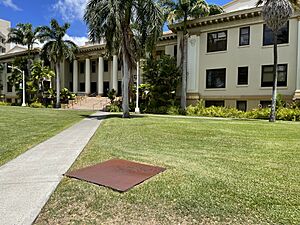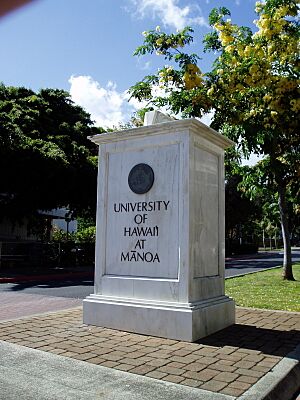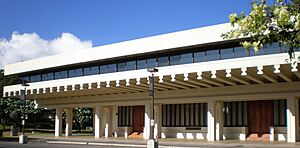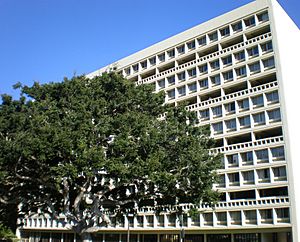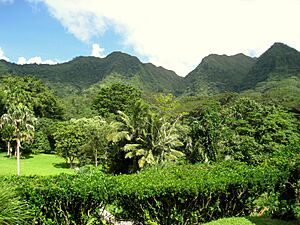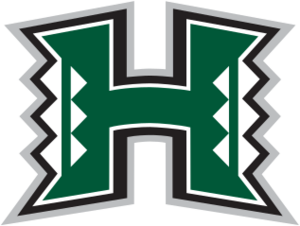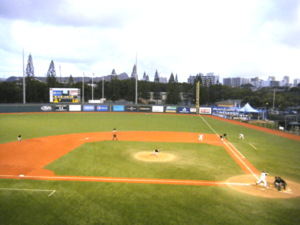University of Hawaiʻi at Mānoa facts for kids
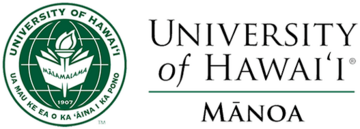 |
|
|
Former name
|
College of Agriculture and Mechanic Arts of the Territory of Hawaiʻi (1907–1912) College of Hawaiʻi (1912–1919) University of Hawaiʻi (1919–1972) |
|---|---|
| Motto | Maluna aʻe o nā lāhui āpau ke ola ke kānaka (Hawaiian) On seal: Mālamalama (Hawaiian) |
|
Motto in English
|
"Above all nations is humanity" On seal: "Enlightenment" |
| Type | Public land-grant research university |
| Established | March 23, 1907 |
|
Parent institution
|
University of Hawaiʻi |
| Accreditation | WSCUC |
|
Academic affiliations
|
|
| Endowment | $341.7 million (system-wide) (2020) |
| Budget | $1.1 billion (2019) |
| President | David Lassner |
| Provost | Michael Bruno |
| Students | 19,098 (Fall 2021) |
| Undergraduates | 14,120 |
| Postgraduates | 4,978 |
| Location |
,
,
United States
21°17′49″N 157°49′01″W / 21.297°N 157.817°W |
| Campus | Large city, 320 acres (1.3 km2) |
| Other campuses | |
| Newspaper | Ka Leo O Hawaiʻi |
| Colors | Green and white |
| Nickname | Rainbow Warriors & Rainbow Wāhine |
|
Sporting affiliations
|
|
The University of Hawaiʻi at Mānoa (often called UH Mānoa or just UH) is a public research university in Mānoa, a neighborhood of Honolulu, Hawaii. It is the main campus of the University of Hawaiʻi system. The campus is mostly in the eastern part of Mānoa Valley. Its medical school is near Kakaʻako Waterfront Park.
UH Mānoa offers more than 200 different degree programs. It is approved by the WASC Senior College and University Commission. The university is known for its high level of research activity. It is one of only four universities in the U.S. that takes part in four special research groups: land-grant, sea-grant, space-grant, and sun-grant.
Many important people have graduated from UH Mānoa. This includes Patsy T. Mink, a former U.S. Congresswoman, and Robert Ballard, a famous ocean explorer. The parents of former U.S. President Barack Obama, Barack Obama Sr. and Stanley Ann Dunham, also went to UH Mānoa.
Contents
History of the University
How UH Mānoa Started
The University of Hawaiʻi at Mānoa began in 1907. It was first called the College of Agriculture and Mechanic Arts of the Territory of Hawaiʻi. This college was created to teach farming and practical skills.
Classes started on September 14, 1908. The first president was John Gilmore. In 1912, the college moved to its current spot in Mānoa Valley and was renamed the College of Hawaii.
Later, in 1919, it became the University of Hawaiʻi. This happened after people asked for it to become a full university. More colleges were added, like the College of Arts and Sciences. In 1931, a school for teachers joined the university, becoming the College of Education.
Growth in the 20th Century
The university grew a lot in the 1930s and 1940s. Its size increased, and more buildings were added. After the attack on Pearl Harbor in 1941, classes stopped for two months. Many students and teachers left to join the war effort.
When classes started again, the campus looked like a military school. Students had to carry gas masks. After the war, many more students enrolled.
In 1947, the university opened a branch in Hilo on Hawaiʻi Island. By the 1950s, over 5,000 students attended. New colleges were added, such as Engineering and Business Administration.
When Hawaiʻi became a state in 1959, the university gained more control over itself. Student numbers kept growing, reaching 19,000 in the 1960s. The campus became well-known for its research.
In 1965, the state created a system of community colleges. These were also placed under the university's management. In 1972, the university was renamed the University of Hawaiʻi at Mānoa. This helped tell it apart from the other campuses in the University of Hawaiʻi System.
How the University is Run
The University of Hawaiʻi is managed by a group of 11 people called the Board of Regents. These people are chosen by the governor and approved by the state legislature.
The Board of Regents also chooses the president of the University of Hawaiʻi. This president is also in charge of the UH Mānoa campus.
What Students Can Study
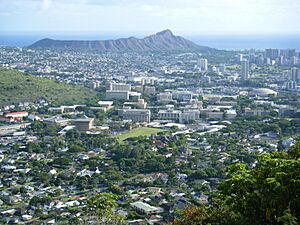
UH Mānoa is a large research university with 17 schools and colleges. Students can earn many different degrees here. This includes degrees in architecture, earth science, business, education, and engineering. There are also special schools for law and medicine.
The university offers bachelor's degrees in 93 subjects. It also has master's degrees in 84 subjects and doctoral degrees in 51 subjects.
College of Tropical Agriculture & Human Resources
This college was the first one established at the university. It focuses on tropical agriculture, food science, and human nutrition. It also covers topics like textiles and human resources.
College of Education
This college started in 1895 as a school to train teachers. It joined the University of Hawaiʻi in 1931. Today, it is called the College of Education and prepares people to become teachers.
College of Arts, Languages & Letters
This is the newest and largest college at the university. It focuses on arts, humanities, and languages. It has a special interest in Hawaiʻi, the Pacific, and Asia.
Shidler College of Business
The College of Business Administration started in 1949. It offered programs in accounting, finance, and marketing. In 2006, it was renamed the Shidler College of Business. This was after a graduate, Jay Shidler, gave a large donation to the college.
Nancy Atmospera-Walch School of Nursing
The School of Nursing was created in 1951. However, nursing classes had been offered since 1932. This was done through a partnership with Queen's Hospital School of Nursing.
Honors Program
UH Mānoa has an Honors Program for students who want extra challenges. Students in this program take special courses. They also need to keep good grades and complete a big project in their final year.
Library
The University of Hawaiʻi at Mānoa Library is one of the largest academic libraries in the United States. It has millions of books, journals, and digital documents.
University Rankings
UH Mānoa is recognized as a good university. For example, U.S. News & World Report ranked it among the top national universities. It also ranked well for its undergraduate engineering program.
Research at UH Mānoa
UH Mānoa is a very active research university. In 2018, it spent $276 million on research and development. Much of this research focuses on Hawaiʻi's land, people, and history.
The university's location helps with studies in marine biology, oceanography, and astronomy. Its ties to Asia and the Pacific also make it a great place for research in arts, languages, and culture.
Most research money comes from U.S. government groups. These include the Department of Health, the Department of Defense, and the National Science Foundation.
A new medical complex opened in 2005. This facility helps with research in biotechnology and cancer.
Cancer Center
The University of Hawaiʻi Cancer Center is part of UH Mānoa. It is a special center for cancer research and treatment. It helps people in Hawaiʻi and the Pacific region. The center opened in 2013 in Kakaʻako.
Student Life
Student Housing
All student dorms at UH Mānoa are for both male and female students. First-year students usually live in traditional dorms. Older students can live in apartment-style buildings. Some units are also set aside for graduate students and families.
Charles H. Atherton YMCA
The YMCA has worked closely with the university since 1908. It offered classes and activities for students. In 1932, the YMCA moved into a building called the Charles H. Atherton House. This building was also used for student housing and dining.
In 2017, the university bought the Atherton building. It is now being renovated to become student housing and an innovation center.
Associated Students of the University of Hawaiʻi
The Associated Students of the University of Hawaiʻi at Manoa (ASUH) is the student government. It represents all the full-time undergraduate students at UH Mānoa. ASUH was started in 1910.
Places Near Campus
- The Lyon Arboretum is a special tropical garden. It is the only one belonging to a U.S. university. It was started in 1918 to study plants and help restore forests. In 1953, it became part of UH Mānoa.
- The Waikiki Aquarium is the third-oldest public aquarium in the United States. It was founded in 1904 and became part of the University of Hawaiʻi in 1919. It is located right next to a living coral reef.
Sports at UH Mānoa
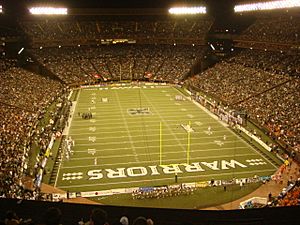
The University of Hawaiʻi at Mānoa competes in NCAA Division I sports. This is the highest level of college sports. The men's teams are called the Rainbow Warriors. The women's teams are called the Rainbow Wahine. Wahine means "woman" in Hawaiian.
UH Mānoa is known for its men's and women's basketball, volleyball, baseball, and football teams. The women's volleyball team won national championships in 1982, 1983, and 1987. The men's volleyball team won an NCAA championship in 2021.
The main sports venues include the Clarence T. C. Ching Athletics Complex and the Stan Sheriff Center.
Famous Alumni and Faculty
Many notable people have studied or taught at UH Mānoa. Here are a few:
- Daniel Inouye, a U.S. Senator.
- Patsy Mink, a former U.S. Congresswoman.
- Robert Ballard, a famous oceanographer.
- Richard Parsons, a well-known businessman.
- Tammy Duckworth, a U.S. Senator.
- Janet Mock, a writer.
- Ann Dunham, an anthropologist and mother of President Barack Obama.
- Robyn Ah Mow-Santos, an Olympian in volleyball.
Art on Campus
The UH Mānoa campus has many interesting artworks. These include:
- The John Young Museum of Art.
- Murals by Jean Charlot, like The Relation of Man and Nature in Old Hawaii.
- Sculptures by artists such as Bumpei Akaji and George Segal.
- Various other sculptures, murals, and art installations across the campus.
Images for kids
-
Hale Mānoa Dormitory, East-West Center designed by I. M. Pei
-
UH Mānoa campus viewed from Round Top Drive, with Diamond Head in the background
-
The off-campus Aloha Stadium, situated near Pearl Harbor in Honolulu, was the home of Rainbow Warrior Football from 1975 to 2020.


